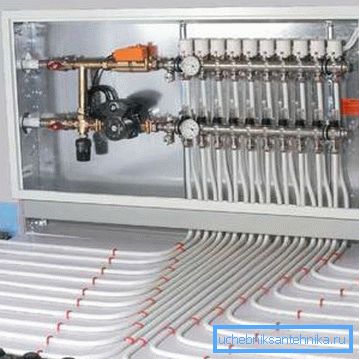Do-it-yourself water heating - expert advice
Options for heating a private house at the moment there are many, ranging from the old stove to the heater and ending with such still exotic as a heat pump or solar collector. But traditionally it is traditionally considered to be heated with a liquid heat carrier or water. Although it may seem problematic to someone, but, nevertheless, to do water heating with your own hands is real and we will discuss this now.
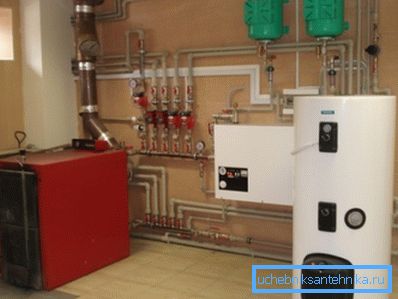
Choice of construction and materials
Of course, heating a private house is not nuclear physics, but in order not to have problems in the future, before you make water heating, you should thoroughly think which system is suitable for your home and from here pick up materials.
Types of designs
First, let's understand the circulation of water in the system. Here there are 3 options, the simplest is the natural flow of water. The work of such a construction is completely based on the elementary laws of physics, heat rises up and cooling down descends. Despite the seeming simplicity to mount such a wiring should be very carefully, clearly observing the angle of inclination.
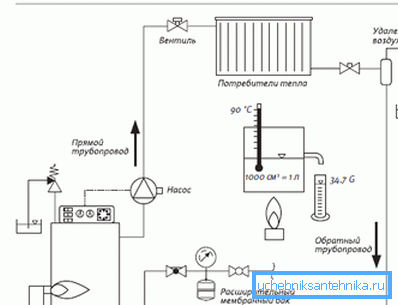
Depending on the length of the line, it can fluctuate within 2-5 ?. But, as a rule, they make it easier; a slope of 10 mm is provided for each linear meter of the line. In this case, the smaller the angles and turns, the higher the efficiency. The expansion tank in this design is mounted at the highest point, its volume, for any system, must be at least 10% of the coolant volume.
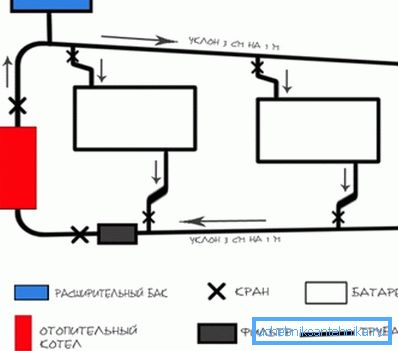
At the moment, the most common are systems with forced circulation of water. An electric circulation pump, which ensures the movement of the coolant at a given speed, simply cuts into a closed loop; the angle of inclination here does not play a big role.
Some experts single out combined systems as a separate group, but this is a controversial issue. A combination is considered to be a system that is able to work with both natural and artificial circulation, but in essence, it is a design with a natural current into which a circulation pump has been inserted.

Advice: since we are going to install an improvised water heating, having only general knowledge in heating engineering, the design with forced circulation will be the best choice. Here you do not have to scrupulously measure out every degree, the pump in any case will ensure normal circulation.
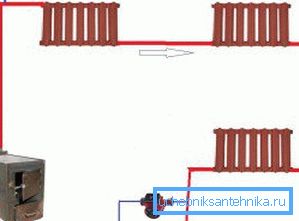
There is also a one-pipe and two-pipe wiring. The first option is usually used with a natural fluid flow, with radiators connected in series in a row. To equalize the temperature, with increasing distance from the boiler, increase the number of radiator sections.
The variant with two-pipe wiring is more progressive, since it allows to achieve the same temperature in all radiators. Simply put, to each point is input and output almost from the boiler. Plus, if you want to make a warm floor, you can equip it only in such a system. But the circulation is forced.

Boiler as the heart of the system
The undisputed, recognized leader here is gas equipment. In comparison with competitors, such heating is perhaps the most economical. The caloric content of the gas is huge, without the need to constantly monitor the furnace and equip a place to store fuel. But, unfortunately, not everywhere there is an opportunity to bring gas.
Important: gas boilers are profitable only if there is a main gas pipeline. Liquefied gas will cost no less than electricity or good coal.
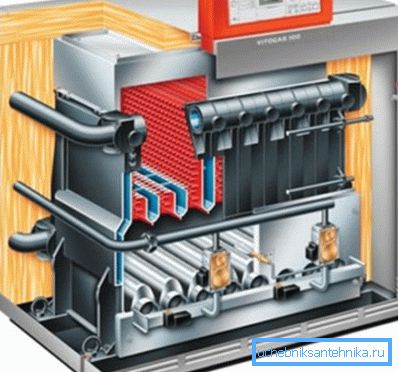
In second place is the electrical equipment. It is environmentally friendly, works silently and does not require such a heap of operating permits.
All that is required is the laying of a three-phase line with a cross section of at least 6 mm ?. Everything is good, but for some reason the price of electricity does not fall and the operation of such a unit will cost a pretty penny.
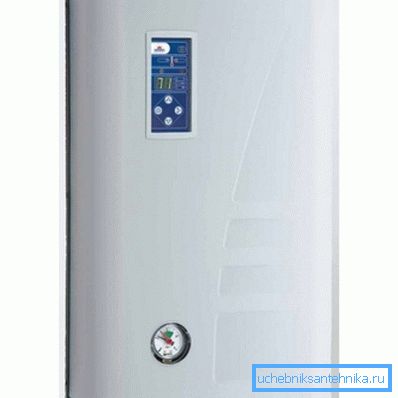
For those to whom the main gas is not available, and the heating with electricity can not afford, a solid boiler will be a good way out. Now universal units are being produced that are practically omnivorous; they can work on any kind of solid fuel, from wood or chips, to coke and pellets. A private, simplified version of such units can be considered traditional brick kilns, with built-in heating registers.

Tip: The story will not be complete if we do not mention liquid fuel boilers. But if you drown diesel fuel or kerosene, then this heating will be gold. Therefore, it is appropriate to speak here only about the units working on the development of oil.
Such fuel costs a penny, moreover, if you search well, then you can find it for free, since many companies will be happy to get rid of it, just not to pay for recycling.
Pipes in the heating system
The most popular in the recent past was metal. Now he was replaced by plastic and metal-plastic. As for steel structures, experts advise using them only for single pipe wiring with natural circulation.
Plus, you need a pipe bender, welding equipment and the ability to professionally cook.
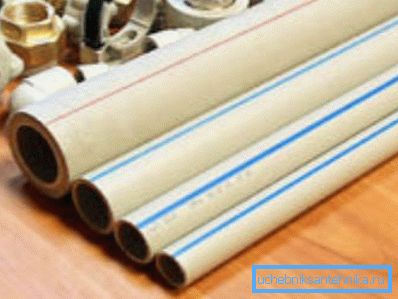
Tip: you can use copper pipes, but the price bites them and you need to solder them only with silver solder, the tin will crack with time.
The device of water heating plastic, at the moment, is the best option, but here there are some subtleties. Kohl, we decided to mount their own hands, it is better to give preference to polypropylene. For welding, you need a special soldering iron and scissors. The instruction on welding is extremely simple, it can be mastered in half an hour.

Metal-plastic pipes are a good thing, but they are not suitable for open wiring, their mechanical strength is too weak. But for the arrangement of a heated floor, metal-plastic is considered to be an almost ideal material.
It is also possible to use reinforced polyethylene under the warm floor, but its quality is worse, plus it is slippery and the fittings on it are not firmly held.
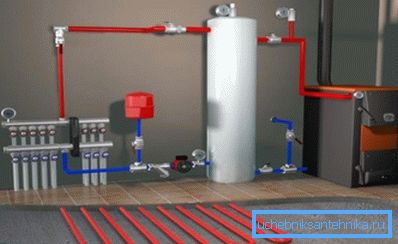
Assembly sequence
- Installation of water heating with their own hands is carried out in a clear, repeatedly proven scheme. Always start with the installation of the main unit, the heating boiler. Ideally, experts advise pouring a separate, small concrete foundation 40–50 mm high under it. But if this is not possible, then you can do with a sheet of iron, on top of which a sheet of asbestos is superimposed.
- When the unit is rigidly installed and fixed, you can proceed to the arrangement of the chimney. For gas equipment, you can get by installing a coaxial pipe, all other types require the installation of a stationary vertical chimney. Gaps and connections are smeared with clay or fireclay solution. Cement can not be used here, it will crack.
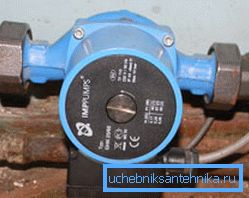
- The boiler room itself should have good ventilation, it can be forced or natural, but in any case it is better to install a special valve on the ventilation outlet to regulate the flow.
- Experts recommend making and withdrawing from the boiler exclusively with metal pipes.. This applies to any type of boiler. Later, at a safe distance, a transition is already being made to the main material of the pipe layout, but the minimum cross-section at the terminal for the metal is 22 mm, for plastic or metal-plastic is 26 mm.
- The diameter of the pipe that enters or leaves the unit must be the same as in the boiler itself.. This section should be maintained until the first branching, after which pipes of smaller diameter are already mounted.
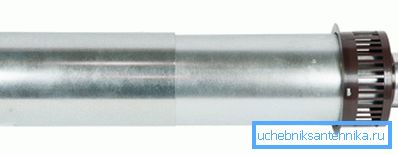
Important: there is a perception that it is better to equip a boiler room in the basement. This is true for all systems except gas - gas units are strictly prohibited to be located in the basement. Moreover, such a boiler house cannot be equipped in a room communicating with the basement, since the gas is heavier than air and in case of leakage it will accumulate at the lowest point, and the consequences are not difficult to predict.
- Next, you need to clearly draw the route of pipe wiring and the place of installation of radiators. The radiators themselves should be placed under window openings. No matter how you warm the house, the windows are a weak point, and the upward flow of heat will block the cold from the window. Also, it will not be superfluous to glue the wall behind the radiator with foil; it will serve as a heat reflector.
- The more bends and sharp corners on the line, the worse the system will work, so all the turns should be made as smooth and rounded as possible.. Ideally, the outlet from the boiler should be below the horizontal line of radiators, this is especially important during natural circulation.

- As mentioned earlier, an expansion tank is installed in any system.. It can be open or sealed. In the first case, it is simply a large tank installed at a height not lower than 3m above the boiler. For structures with natural current, it is installed at the output, near the radiators.
- Hermetic expansion tank divided in half by a membrane. Below is the water above the air. In the case of raising the level of the liquid, the membrane bends and creates excessive pressure. When the temperature returns to normal, the fluid is squeezed back into the system. Mount such a node can be anywhere.
- After mounting the radiator line, the pipe returns to the boiler. Here, before the unit, as a rule, a circulation pump is installed, but in front of it, in the section between the radiators and the pump, a filter is necessarily mounted.
- Do not forget to install a drain valve at the lowest point of the system, for emergency discharge or planned water injection.
The video shows the subtleties of organizational work and installation.
Conclusion
Summing up all the above, I would like to note that the initial launch of the system should be carried out under the guidance of a specialist. Moreover, it is desirable that this was a real, certified professional, advice from a “competent” neighbor can cost more.
